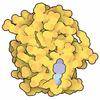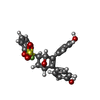[English] 日本語
 Yorodumi
Yorodumi- PDB-4znh: Crystal Structure of the ER-alpha Ligand-binding Domain (Y537S) i... -
+ Open data
Open data
- Basic information
Basic information
| Entry | Database: PDB / ID: 4znh | ||||||
|---|---|---|---|---|---|---|---|
| Title | Crystal Structure of the ER-alpha Ligand-binding Domain (Y537S) in complex with a 2-Fluoro-substituted OBHS derivative | ||||||
 Components Components |
| ||||||
 Keywords Keywords | TRANSCRIPTION / Nuclear receptor / transcription factor / ligand binding / protein-ligand complex | ||||||
| Function / homology |  Function and homology information Function and homology informationregulation of epithelial cell apoptotic process / RNA polymerase II intronic transcription regulatory region sequence-specific DNA binding / antral ovarian follicle growth / regulation of branching involved in prostate gland morphogenesis / RUNX1 regulates transcription of genes involved in WNT signaling / RUNX1 regulates estrogen receptor mediated transcription / regulation of toll-like receptor signaling pathway / nuclear estrogen receptor activity / epithelial cell development / steroid hormone receptor signaling pathway ...regulation of epithelial cell apoptotic process / RNA polymerase II intronic transcription regulatory region sequence-specific DNA binding / antral ovarian follicle growth / regulation of branching involved in prostate gland morphogenesis / RUNX1 regulates transcription of genes involved in WNT signaling / RUNX1 regulates estrogen receptor mediated transcription / regulation of toll-like receptor signaling pathway / nuclear estrogen receptor activity / epithelial cell development / steroid hormone receptor signaling pathway / epithelial cell proliferation involved in mammary gland duct elongation / prostate epithelial cord elongation / prostate epithelial cord arborization involved in prostate glandular acinus morphogenesis / locomotor rhythm / mammary gland branching involved in pregnancy / uterus development / negative regulation of smooth muscle cell apoptotic process / aryl hydrocarbon receptor binding / vagina development / TFIIB-class transcription factor binding / cellular response to Thyroglobulin triiodothyronine / regulation of lipid metabolic process / androgen metabolic process / regulation of glucose metabolic process / Synthesis of bile acids and bile salts / mammary gland alveolus development / cellular response to estrogen stimulus / estrogen response element binding / Synthesis of bile acids and bile salts via 27-hydroxycholesterol / Endogenous sterols / Synthesis of bile acids and bile salts via 7alpha-hydroxycholesterol / Mitochondrial unfolded protein response (UPRmt) / nuclear receptor-mediated steroid hormone signaling pathway / positive regulation of DNA-binding transcription factor activity / negative regulation of DNA-binding transcription factor activity / Nuclear signaling by ERBB4 / cellular response to hormone stimulus / RNA polymerase II preinitiation complex assembly / Recycling of bile acids and salts / transcription regulator inhibitor activity / positive regulation of nitric-oxide synthase activity / estrogen receptor signaling pathway / protein localization to chromatin / steroid binding / : / 14-3-3 protein binding / positive regulation of adipose tissue development / Regulation of lipid metabolism by PPARalpha / TFAP2 (AP-2) family regulates transcription of growth factors and their receptors / negative regulation of canonical NF-kappaB signal transduction / peroxisome proliferator activated receptor signaling pathway / regulation of cellular response to insulin stimulus / BMAL1:CLOCK,NPAS2 activates circadian expression / SUMOylation of transcription cofactors / ESR-mediated signaling / Activation of gene expression by SREBF (SREBP) / response to progesterone / TBP-class protein binding / negative regulation of miRNA transcription / nitric-oxide synthase regulator activity / nuclear estrogen receptor binding / nuclear receptor binding / transcription corepressor binding / transcription coregulator binding / negative regulation of smoothened signaling pathway / stem cell differentiation / SUMOylation of intracellular receptors / circadian regulation of gene expression / cellular response to estradiol stimulus / mRNA transcription by RNA polymerase II / Heme signaling / euchromatin / Transcriptional activation of mitochondrial biogenesis / PPARA activates gene expression / Cytoprotection by HMOX1 / Activated PKN1 stimulates transcription of AR (androgen receptor) regulated genes KLK2 and KLK3 / beta-catenin binding / Nuclear Receptor transcription pathway / Transcriptional regulation of white adipocyte differentiation / response to estrogen / transcription coactivator binding / RNA polymerase II transcription regulator complex / male gonad development / nuclear receptor activity / positive regulation of fibroblast proliferation / Constitutive Signaling by Aberrant PI3K in Cancer / Regulation of RUNX2 expression and activity / positive regulation of nitric oxide biosynthetic process / sequence-specific double-stranded DNA binding / Ovarian tumor domain proteases / : / response to estradiol / PIP3 activates AKT signaling / HATs acetylate histones / positive regulation of cytosolic calcium ion concentration / ATPase binding / MLL4 and MLL3 complexes regulate expression of PPARG target genes in adipogenesis and hepatic steatosis / PI5P, PP2A and IER3 Regulate PI3K/AKT Signaling / regulation of inflammatory response / fibroblast proliferation Similarity search - Function | ||||||
| Biological species |  Homo sapiens (human) Homo sapiens (human) | ||||||
| Method |  X-RAY DIFFRACTION / X-RAY DIFFRACTION /  SYNCHROTRON / SYNCHROTRON /  MOLECULAR REPLACEMENT / Resolution: 1.933 Å MOLECULAR REPLACEMENT / Resolution: 1.933 Å | ||||||
 Authors Authors | Nwachukwu, J.C. / Srinivasan, S. / Zheng, Y. / Wang, S. / Min, J. / Dong, C. / Liao, Z. / Cavett, V. / Nowak, J. / Houtman, R. ...Nwachukwu, J.C. / Srinivasan, S. / Zheng, Y. / Wang, S. / Min, J. / Dong, C. / Liao, Z. / Cavett, V. / Nowak, J. / Houtman, R. / Carlson, K.E. / Josan, J.S. / Elemento, O. / Katzenellenbogen, J.A. / Zhou, H.B. / Nettles, K.W. | ||||||
 Citation Citation |  Journal: Mol.Syst.Biol. / Year: 2016 Journal: Mol.Syst.Biol. / Year: 2016Title: Predictive features of ligand-specific signaling through the estrogen receptor. Authors: Nwachukwu, J.C. / Srinivasan, S. / Zheng, Y. / Wang, S. / Min, J. / Dong, C. / Liao, Z. / Nowak, J. / Wright, N.J. / Houtman, R. / Carlson, K.E. / Josan, J.S. / Elemento, O. / ...Authors: Nwachukwu, J.C. / Srinivasan, S. / Zheng, Y. / Wang, S. / Min, J. / Dong, C. / Liao, Z. / Nowak, J. / Wright, N.J. / Houtman, R. / Carlson, K.E. / Josan, J.S. / Elemento, O. / Katzenellenbogen, J.A. / Zhou, H.B. / Nettles, K.W. | ||||||
| History |
|
- Structure visualization
Structure visualization
| Structure viewer | Molecule:  Molmil Molmil Jmol/JSmol Jmol/JSmol |
|---|
- Downloads & links
Downloads & links
- Download
Download
| PDBx/mmCIF format |  4znh.cif.gz 4znh.cif.gz | 122.8 KB | Display |  PDBx/mmCIF format PDBx/mmCIF format |
|---|---|---|---|---|
| PDB format |  pdb4znh.ent.gz pdb4znh.ent.gz | 93.3 KB | Display |  PDB format PDB format |
| PDBx/mmJSON format |  4znh.json.gz 4znh.json.gz | Tree view |  PDBx/mmJSON format PDBx/mmJSON format | |
| Others |  Other downloads Other downloads |
-Validation report
| Summary document |  4znh_validation.pdf.gz 4znh_validation.pdf.gz | 1.3 MB | Display |  wwPDB validaton report wwPDB validaton report |
|---|---|---|---|---|
| Full document |  4znh_full_validation.pdf.gz 4znh_full_validation.pdf.gz | 1.3 MB | Display | |
| Data in XML |  4znh_validation.xml.gz 4znh_validation.xml.gz | 24.8 KB | Display | |
| Data in CIF |  4znh_validation.cif.gz 4znh_validation.cif.gz | 35.4 KB | Display | |
| Arichive directory |  https://data.pdbj.org/pub/pdb/validation_reports/zn/4znh https://data.pdbj.org/pub/pdb/validation_reports/zn/4znh ftp://data.pdbj.org/pub/pdb/validation_reports/zn/4znh ftp://data.pdbj.org/pub/pdb/validation_reports/zn/4znh | HTTPS FTP |
-Related structure data
| Related structure data |  4zn7C  4znsC  4zntC 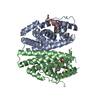 4znuC  4znvC  4znwC  5di7C  5didC  5dieC 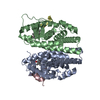 5digC 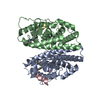 5dk9C  5dkbC  5dkeC 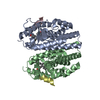 5dkgC  5dksC 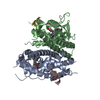 5dl4C  5dlrC  5dmcC  5dmfC  5dp0C  5drjC  5drmC 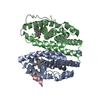 5dtvC  5du5C 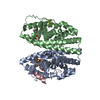 5dueC  5dugC  5duhC  5dvsC  5dvvC  5dweC  5dwgC  5dwiC  5dwjC  5dxkC  5dxmC  5dxpC  5dxqC  5dxrC  5dy8C  5dybC  5dydC  5dz0C  5dz1C  5dz3C  5dzhC  5dziC  5e0wC  5e0xC 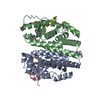 5e14C  5e15C  5e19C  5e1cC  5egvC  5ehjC  5ei1C  5eitC 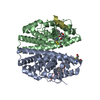 2qa8S C: citing same article ( S: Starting model for refinement |
|---|---|
| Similar structure data |
- Links
Links
- Assembly
Assembly
| Deposited unit | 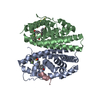
| ||||||||
|---|---|---|---|---|---|---|---|---|---|
| 1 |
| ||||||||
| Unit cell |
|
- Components
Components
| #1: Protein | Mass: 29329.457 Da / Num. of mol.: 2 / Fragment: ligand-binding domain, UNP residues 301-559 / Mutation: Y537S Source method: isolated from a genetically manipulated source Source: (gene. exp.)  Homo sapiens (human) / Gene: ESR1, ESR, NR3A1 / Production host: Homo sapiens (human) / Gene: ESR1, ESR, NR3A1 / Production host:  #2: Protein/peptide | Mass: 1579.866 Da / Num. of mol.: 2 / Fragment: UNP residues 686-698 / Source method: obtained synthetically / Source: (synth.)  Homo sapiens (human) / References: UniProt: Q15596 Homo sapiens (human) / References: UniProt: Q15596#3: Chemical | #4: Water | ChemComp-HOH / | |
|---|
-Experimental details
-Experiment
| Experiment | Method:  X-RAY DIFFRACTION / Number of used crystals: 1 X-RAY DIFFRACTION / Number of used crystals: 1 |
|---|
- Sample preparation
Sample preparation
| Crystal | Density Matthews: 2.19 Å3/Da / Density % sol: 43.95 % |
|---|---|
| Crystal grow | Temperature: 294 K / Method: vapor diffusion, hanging drop / pH: 8.3 / Details: 15% PEG 3350, 0.05M MgCl2, 0.067M NaCl, 0.1M Tris |
-Data collection
| Diffraction | Mean temperature: 100 K | ||||||||||||||||||||||||||||||||||||||||||||||||||||||||||||||||||||||||||||||||||||||||||||||||||||||||||||||||||||||||||||||
|---|---|---|---|---|---|---|---|---|---|---|---|---|---|---|---|---|---|---|---|---|---|---|---|---|---|---|---|---|---|---|---|---|---|---|---|---|---|---|---|---|---|---|---|---|---|---|---|---|---|---|---|---|---|---|---|---|---|---|---|---|---|---|---|---|---|---|---|---|---|---|---|---|---|---|---|---|---|---|---|---|---|---|---|---|---|---|---|---|---|---|---|---|---|---|---|---|---|---|---|---|---|---|---|---|---|---|---|---|---|---|---|---|---|---|---|---|---|---|---|---|---|---|---|---|---|---|---|
| Diffraction source | Source:  SYNCHROTRON / Site: SYNCHROTRON / Site:  APS APS  / Beamline: 23-ID-B / Wavelength: 0.9 Å / Beamline: 23-ID-B / Wavelength: 0.9 Å | ||||||||||||||||||||||||||||||||||||||||||||||||||||||||||||||||||||||||||||||||||||||||||||||||||||||||||||||||||||||||||||||
| Detector | Type: MAR scanner 300 mm plate / Detector: IMAGE PLATE / Date: Dec 18, 2010 | ||||||||||||||||||||||||||||||||||||||||||||||||||||||||||||||||||||||||||||||||||||||||||||||||||||||||||||||||||||||||||||||
| Radiation | Monochromator: Si (111) / Protocol: SINGLE WAVELENGTH / Monochromatic (M) / Laue (L): M / Scattering type: x-ray | ||||||||||||||||||||||||||||||||||||||||||||||||||||||||||||||||||||||||||||||||||||||||||||||||||||||||||||||||||||||||||||||
| Radiation wavelength | Wavelength: 0.9 Å / Relative weight: 1 | ||||||||||||||||||||||||||||||||||||||||||||||||||||||||||||||||||||||||||||||||||||||||||||||||||||||||||||||||||||||||||||||
| Reflection | Resolution: 1.93→50 Å / Num. obs: 31971 / % possible obs: 83 % / Redundancy: 3.4 % / Biso Wilson estimate: 19.09 Å2 / Rmerge(I) obs: 0.076 / Χ2: 1.762 / Net I/av σ(I): 20.569 / Net I/σ(I): 12 / Num. measured all: 109857 | ||||||||||||||||||||||||||||||||||||||||||||||||||||||||||||||||||||||||||||||||||||||||||||||||||||||||||||||||||||||||||||||
| Reflection shell | Diffraction-ID: 1 / Rejects: _
|
- Processing
Processing
| Software |
| ||||||||||||||||||||||||||||||||||||||||||||||||||||||||||||||||||||||||||||||||||||||||||||||||||
|---|---|---|---|---|---|---|---|---|---|---|---|---|---|---|---|---|---|---|---|---|---|---|---|---|---|---|---|---|---|---|---|---|---|---|---|---|---|---|---|---|---|---|---|---|---|---|---|---|---|---|---|---|---|---|---|---|---|---|---|---|---|---|---|---|---|---|---|---|---|---|---|---|---|---|---|---|---|---|---|---|---|---|---|---|---|---|---|---|---|---|---|---|---|---|---|---|---|---|---|
| Refinement | Method to determine structure:  MOLECULAR REPLACEMENT MOLECULAR REPLACEMENTStarting model: 2QA8 Resolution: 1.933→40.783 Å / SU ML: 0.27 / Cross valid method: FREE R-VALUE / σ(F): 0 / Phase error: 27.93 / Stereochemistry target values: ML
| ||||||||||||||||||||||||||||||||||||||||||||||||||||||||||||||||||||||||||||||||||||||||||||||||||
| Solvent computation | Shrinkage radii: 0.9 Å / VDW probe radii: 1.11 Å / Solvent model: FLAT BULK SOLVENT MODEL | ||||||||||||||||||||||||||||||||||||||||||||||||||||||||||||||||||||||||||||||||||||||||||||||||||
| Displacement parameters | Biso max: 103.32 Å2 / Biso mean: 27.8216 Å2 / Biso min: 2.32 Å2 | ||||||||||||||||||||||||||||||||||||||||||||||||||||||||||||||||||||||||||||||||||||||||||||||||||
| Refinement step | Cycle: final / Resolution: 1.933→40.783 Å
| ||||||||||||||||||||||||||||||||||||||||||||||||||||||||||||||||||||||||||||||||||||||||||||||||||
| Refine LS restraints |
| ||||||||||||||||||||||||||||||||||||||||||||||||||||||||||||||||||||||||||||||||||||||||||||||||||
| LS refinement shell | Refine-ID: X-RAY DIFFRACTION / Total num. of bins used: 13
|
 Movie
Movie Controller
Controller





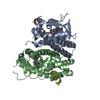
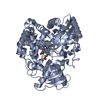


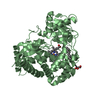
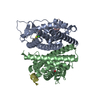


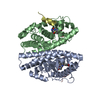
 PDBj
PDBj



